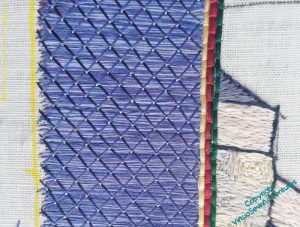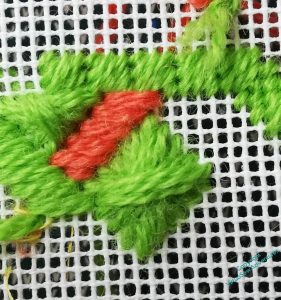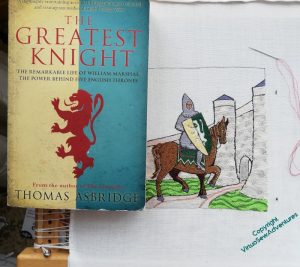Category: General Embroidery
William’s Border – the background..
As you can imagine, it took me some time to decide on the way I was going to tackle the border. Since the “sky” is going to be underside couched in gold, it needed something to contain it, and I felt that it had to be a colour which wasn’t already dominant in the design – so not grey, and not brown.
Blue somehow became the obvious choice, and then I had to decide how to do it. I wanted the colour to have a bit of variation to make it less stark, but at the same time, calm enough to settle into the background. So I have three different shades of blue in the needle at once, and the base layer is surface satin stitch.
That isn’t at all stable, so it is going to have trellis couching over the top.
The first layer has a slightly watery look to it, not at all unsuitable for someone who travelled as much as William, but I wanted to calm it down some more, because, remember, it’s merely the background for broom and dog roses! So the hatching (the trellis part) uses the two darker shades of the three.
The final stage is tieing stitches, in the lightest blue. I’m really pleased with this, as it has produced the right control of the threads, and the light blue glints like a gem at the crossing points.
The outer edge will have the same as the inner edge, but in the reverse order. Soon I will have to finalise the ideas for the broom and dog roses, and when I’ve done that there will be no excuse to avoid the underside couching, the prospect of which is slightly unnerving me..
More thinking about that border design
Once I’d got the panel done and got started on the background for the border, I knew that I was going to have a lot to do before the next stage of decorating the border. So I got out my paints, and started to play with the design elements I want to pull together – broom and dog roses.
My first effort, based on the drawings in the Observers Book of Wild Flowers, ended up as one of each, rather than a combination, so I knew I needed to think about that a little more; but I also realised that unless I worked out how the combination was going to be applied, I was going to end up doing a lot of work in the wrong direction.
So. Layout. I had begun by thinking about a wreath, but somewhere along the way, it turned into sprigs, and then I started to think about adding another motif – the cross the Knights Templar used, for Temple Church, where William is buried.
Combining the idea of the sprigs with the Templar cross, I’ve got four possible layouts, one with a cross at each corner, one with the cross in the middle of each side, and one with crosses on the the diagonals. At the moment, I am leaning towards the one with the cross in the centre of each side. The corner crosses seem to make a less purposeful pattern, somehow, and the diagonals – well, depending on the final form of the sprigs, they may work in the end, but at the moment, I’m not at all convinced!
When in doubt, delegate!
You may recall that I was beginning to think about assembling the Amarna panels, and suffering from Alarms, because I wasn’t sure how to make suitable mounts.
I was beginning to think about finding a timber merchant (our local one has closed) when a carpenter and his apprentice came to do some (very necessary) work on our windows. It didn’t take long to realise that they are both fine craftsmen, and it occurred to me that the intelligent choice was to ask whether, during the couple of days when they worked on things in the workshop, they could also make me some mounting frames for my embroidery.
Not only could they do so, but they made a beautiful job of them, as you can see from this test layout of one set of the panels. The wood has been sanded smooth so as not to snag either the cloth or the embroiderer, and there is some bracing to keep everything square and true. It seems a crime to cover them…
In fact, I was so thrilled with them, that I promptly asked for mounting frames for Akhenaten and Nefertiti as well!
Once I had them all, I decided the first thing to do was to cover each with a layer of calico to support the padding.
My word, that was a task. I’m very pleased with the results, but before I start covering them with the padding, and the real fabric, I need to have a break from the staple gun. It has a kick like a Victorian army mule, and very nearly as bad a temper!
Moving on with William
Here is William’s lion rampant gules (red), duly completed. As I’ve mentioned, technically the background should be gold and green (or and vert, in heraldic terminology), but I don’t want the gold on the shield to argue with the gold of the underside couching, so I’ve gone for a pale yellow instead. All things considered, I don’t think the lion is too bad, because he’s really rather small, so I didn’t have very much room for manoevre!
That said, I may choose to tweak him some more before the whole thing is finished..
Now then, I need to move on to the frame for this picture, which is going to be the backdrop for the twined roses and gorse. The main border will be blue, but as I was thinking about it, I felt that the junction between the picture and the border needed to be managed.
This is what I’ve come up with: single lines of William’s three heraldic colours framing the picture in laid and couched work. I’m intending to finish the other side of the blue border with the same, but with the colours in reverse order.
But before I get to that I have to do the blue border, and as I’m intending to use trellis couching, it will be a while yet – three layers of stitching, background, trellis and tie stitches all to do. I’m using thread from three reels of slightly different blues, so there will be some variation in the colour, although as I’m intending to use a single colour for the trellis, it should settle back into a subtle backdrop for the gorse and the roses.
Mystery Finished
Remember this?
I found it on the blocking board and decided that it would be Finished And Done this year.
One of the reasons I didn’t persevere with it the last time I found it was that I was rather daunted by redrawing the bits of the transfer which had worn away while it was hidden – or maybe not transferred properly in the first place.
In particular, the bottom row was a procession of Horse Guards, and horses are rather tricky to draw. I was interested to find that the past few years of working on my painting and drawing had made me much more calm in the face of that particular challenge. I don’t say my horses are particularly good, but they don’t look like elephants, and I count that a win!
I also decided that, since there was no way I could reconstruct the way the design was intended to be done, I would do something different, so all my additions are line stitched.

Apart from the border, which as you see I have blanket stitched to create the effect of one of those striped borders some banners have. Another alteration was to make the faces of the troupers a variety of different shades. A few years ago I might have picked one shade and used it for all of them, more concerned with pattern than verisimilitude, but our Armed Forces have never been restricted to white Britons, and now I am more concerned not to obliterate that service in the name of Design.
And it was finished before the death of Her Majesty Queen Elizabeth II. If, as I half-suspect, it was a magazine design for the Coronation, I managed to finish it within the 70 years of her reign.
Bemusements and puzzles
You may well wonder what on earth I am doing, posting a picture of the The Observer’s Book of Wild Flowers on an embroidery blog.
Well, I want to do a sort of illustrated border around William with “Planta Genista”, which I am told is the Common Broom, intertwined with roses. Broom, for the Plantagenet kings he served unflinchingly for sixty years or so, roses for the garden the Victorians transplanted him to when they dug him up.
However, I have a bit of a quandary.



I would like to create the wreath myself, and spent more time than I like online, turning up pictures of bushes or else someone else’s border designs, so I thought I’d consult paper instead. Where I find “Broom” and “Furze” – and “Needle-Whin”, which I have never heard of, but carries the name “genista anglica”. And any one of those – or none – could also be the thing I know as “Gorse”.
I may find myself fudging that one slightly…
As for the roses?
Dog roses, I think. They are the roses William would have known, their simplicity may help me to balance the very spiky broom, and I think that pale pink and white will make great use of the pink and cream of the castle.
Testing, Testing (phase 3)
There is still much to play with, with regards to the the stitching for the Knot Garden Parterre.
At this point, I’m trying to balance accurate impressions – and therefore useful testing – with not tearing my thread to pieces or wasting any of it. At present I am still thinking of doing this out of stash, if possible, which is why I’m using an impossibly bright shade of green here – I’m unlikely to want it in the real thing!
Now, you see here that the short Parisian Stitch enticed me into a broader strap than I was intending, and it has unbalanced the Mosaic Stitch of the border, which in turn became Scotch Stitch as it turned into the diagonal, and lost the pattern it had.
Here, by contrast, I have demonstrated one of the other hazards of canvaswork, especially for my astigmatic eyes – I’ve suddenly managed to turn a Diagonal Rhodes Stitch into a slightly oblong and twisted diagonal Rhodes stitch. I didn’t see it happening, so I am going to have to guard against it with some care.
I think I need to make my stitches and straps bigger, too: the shape drawn on the canvas is the size of one of the ones on the finished piece, and I started the outer border on the centreline, and turned onto the diagonal at the appropriate point. The first horizontal row of diamonds should have two in it. Two properly square diamonds, that is!
And here you see the challenge I need to address: the diagonal Rhodes Stitches start with a horizontal or vertical stitch, so what I need in the angle between the straps is a gap (as you see top and bottom of this intersection) and not a thread (as you see left and right)
At this point I’ve been stitching and unstitching so often that I have lost count of myself, and keep on losing track of the stitch lengths I intend, so there will be a pause to regroup!
William Himself
I started William with his leg in its mail, narrow highlight down the front and darker shadows around the back.
I’m going to try to shorten my stitches slightly on William, to emphasise the texture of the mail, and to help throw the shield forward. I want to make that, by contrast, as smooth and glossy as I can – part of the counterchange of texture I am pulling in to the whole piece.
The saddlecloth really does need a bit more red, I think. Something for a later moment.
I’ve tried to make the stitches on William himself suggest the shape of the body, except for the scalloped edge to the mail coif he’s wearing, which breaks up the shape, and adds a bit more detail. I find myself rather fearing that the scalloped edge on the mail coif is more reminiscent of a Fair Isle sweater than anything else, but I hope that the balance of the whole thing will prevent that.
I did the face in tiny stitches, using a single length of silk. Arguably the perspective is a bit off, the face more turned towards us than the head or boady, but I daren’t attempt to unpick it!
The shield stitchery is fairly simple in concept – I wanted to make the green and cream (it should be gold, but I don’t want it to argue with the underside couching) as smooth and straight as possible, and in doing so I didn’t really consider how I was going to address the failings in drawing the lion rampant.
So this is how I am going to do it – by having a source picture ( in this case the cover art from Thomas Ashbridge’s biography of William) balanced beside me on the frame, and using it as a reference, rather as I used the photo when I was stitching Ankhsenspaaten.
When I have completed the lion rampant, I need to make my final decision on where the edges of the underside couched gold are to be, and work the border to make those edges crisp. So more silk to work for a while..
Testing, Testing (phase 2)
I’ve been playing around with possible stitches for the pathway in the Knot Garden. In the source picture, it looks to be made of bricks laid in a pattern, rather like a parquet floor.
I don’t feel I’m obliged to replicate that pattern, but this one on the left is altogether too square, and won’t help the sense of movement I’m going to need to counterbalance the borders, which I rather expect to be rather static, given all the Diagonal Rhodes Stitch that’s going to be happening.
The one on the right is the same Medieval Mosaic Stitch from Jo Ippolito Christensen that I used, voided, in the sunglasses case, but this time worked exactly as diagrammed. I like it, and it’s easy enough to work, but I don’t think it does the job I will be asking it to. I’m sure I will work it for real one day, but not for this project!
When I replaced the stitches that were voided in the sunglasses case with stitches in a different colour and thread, to point up the woven pattern, I got something a lot more hopeful…
I like this one a lot. Although I must admit it does rather recall the diaperwork you sometimes see on Tudor buildings, so maybe not very floor-like!
And then I found another, one that actually looks a lot like herringbone brickwork without any adaptation.
I like this one a lot, too.
I will have to see which of these presents itself most strongly when I’ve got more of the ideas crystallised.
Adding the saddlecloth and other details
I still have some doubts about the tail I gave Mars, but I also still think that any changes are “tweaks” to be left until I have most of the piece finished and just need to balance it out.
And no, I’ve not forgotten that he needs reins and a few other pieces of tack, but those are details that I didn’t want to have to stitch around. I’m not quite sure how and where they are going to run, although as far as I’m aware William would have steered using reins held in the hands, rather than using the feet, as you see the riders of the the drum horses in mounted bands doing, or as I read the ancient Scythians did (although they were archers!).
I wanted to do the saddle cloth in William’s heraldic colours, and I wanted the extra interest from the points, but I am not entirely sure I’m happy with the colour balance and shapes. I am wondering whether I should make the red line a little wider, or even fill that whole section in red.
Another tweak I am considering is a couple of tiny stitches to highlight the blued steel horseshoes. I have light lines running down the horse’s leg, but not onwards, and while it’s the tiniest of details, I remember realising with some of the Thistle Threads pieces just how much of an impact a tiny detail can have..
I’ve couched several strands of silk together to make a headstall and reins, and again, there may be tiny details to add, when the shield is in place, to help create the right sense of William, as the wealthy and successful tournament winner, high in the favour of Henry The Young King, on a visit to the kinsman under whose auspices he trained, dripping in tournament bling, and generally showing off a bit.
He settled down as he got older, but given that his father was rather unsatisfactory, and even the Lord of Tancaville dropped him at an inconvenient moment in his youth, a bit of rubbing their noses in his success would be only human!





























